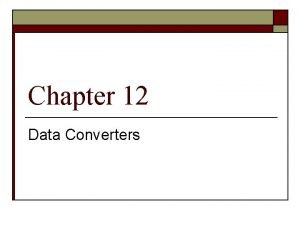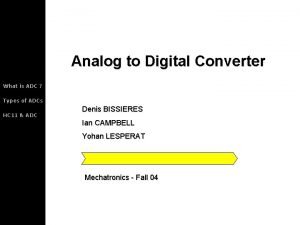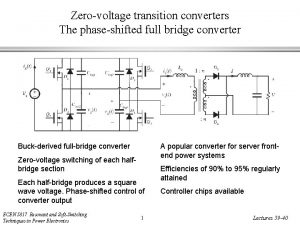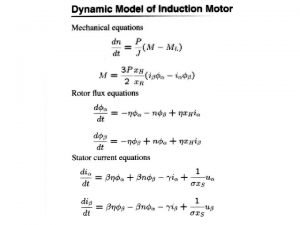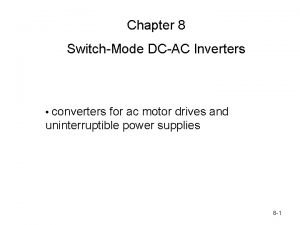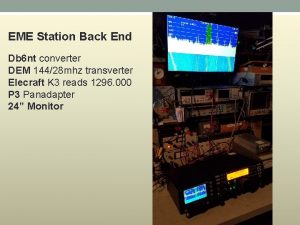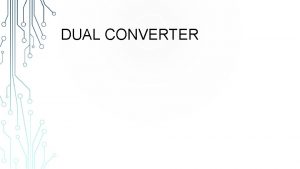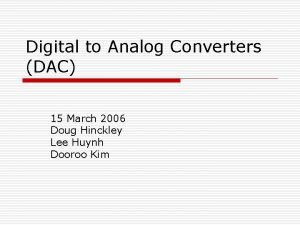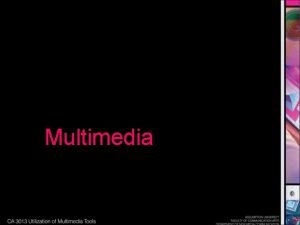Digital to Analog Converters DAC What is a









- Slides: 9

Digital to Analog Converters (DAC) What is a DAC? The Digital to Analog Converter (DAC) is used to convert digital signal to an analog voltage or current output. Analog Output Digital input 1 - The Weighted –Resistor DAC. Digital input MSB LSB Analog Output Load Resistor RL>>R

99 The output voltage, VA, may be found using Millman's theorem: Assume that: Logic "0" =0 V Logic "1"=+7 V * VIH = VIN High a o 2 o + a 121 + ⋯. +an− 12 n− 1 Vo = ∗ Vin. H 2 n − 1 Digital I/P 000 001 010 011 100 Output Vo 0 v 1 v 2 v 3 v 4 v

101 110 111 5 v 6 v 7 v 100 Example 1: For a 4 input resistive divider (0=0 V, 1=10 V) find a. The full-scale output voltage. b. The output voltage change due to the LSB. c. The analog output voltage for a digital input of 1011. Sol. : a)The max. Output voltage occurs when all the input (1111) at +10 V (ignoring the effects of RL). b)0→ 15 the LSB must be equal to 1/15 of the full scale output. Therefore the change in the output voltage due to the LSB is +10 * 1/15 = +2/3 V c) Using Millman's theorem, the output voltage for a digital input of 1011 is: Vo = a o 2 0 + a 1 21 +⋯+ a n− 1 2 n − 1 1 ∗ 2 o + 1 ∗ 21 +0 ∗ 22 +1 ∗ 23 24 − 1 Vo =110 / 15 =7. 33 v × Vin H × 10

H. W: For a five-bit resistive divider, determine: a) The weight assigned to the LSB and also the second and the third LSB. B) The change in output voltage due to a change in the LSB. C)The output voltage for a digital input of 10110. Assume 0= 0 V and 1= +10 V. 101 2 - The R-2 R Ladder DAC. Digital Input Analog Output Assume that Logic "0" = 0 v Logic "1" = 10 v o Vo = 1 n− 1 a o 2 +a 1 2 +⋯+a n− 1 2 2 n ∗ VIH

3 - Feedback Amplifier DAC. Vo V ref = − F. B Resistor Ri 102 For R 1 = R, R 2 = 2 R, R 3 = 4 R, R 4 = 8 R, R i = R Vo = Vref [ a 1 R+a 2 ( 2 R ) +a 3 ( 4 R ) +a 4 (8 R) R ] Vo = Vref(a 1 + 2 a 2 + 4 a 3 + 8 a 4) Multiplying DAC [MDAC] ai = { 01 SSwwi ittcchhisiscol opseend } 4 - Simple D/A converter using op-amp summing amplifier.

103 Example 2: So we shall assume that 0 = 0 V and 1 = 8 V When input DCBA = 0000, then putting these value in above equation (1) we get: When digital input of the circuit DCBA = 0001, then putting these value in above equation (1) we get :

When digital input of the circuit DCBA = 0010, then putting these value in above equation (1) we get : Resolution: The number of bits making up the input data word that will ultimately determine the output step voltage as a percentage of full-scale output voltage. Example 3: Calculate the resolution of an 8 -bit DAC. Solution: Resolution = 8 bits Percentage resolution = 104 Design of D/A Converter: To complete the design of the D/A converter, there must be a register which can be used to store the digital information, there must be level amplifiers between the register and the resistive network to insure that the digital signals presented to the network are all of the same level and are constant.

The level amplifiers each have two inputs: one input is the +10 v from the precision voltage source, and the other is from a flip- flop. When the input from a flip- flop is high, the output of the amplifier is at +10 v. When the input from the flip- flop is low, the output is 0 v. 105 Example 4: Design a four bit digital to analog converter using the Ladder type as a resistive divider.

Digital Input Four Bit Analog to Digital Converter 106
